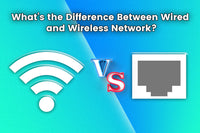WAN vs LAN: What’s the Difference?
Contents [show]
If you take a look at your router, you may find different ports printed with WAN or LAN. It is known that WAN means Wide Area Network and LAN means Local Area Network. Many people may not care about the meaning of WAN and LAN and some people may be more familiar with LAN. Read on this article and take time out to understand how WAN differs from LAN.
What is Local Area Network? (LAN)
LAN, the complete form of which is Local Area Network, is a group of computers that are connected in a limited area such as the office building, home, and campus. They often share the same router or switch. And your computer, tablet, and laptops are the part of Local Area Network. A LAN can be small or large. For example, a home network is single and small, while a business network is usually large covering a lot of users and devices.
Ethernet and Wi-Fi are the two most common network technology used in Local Area Network. For example, to meet the requirement for higher network speed, there are Cat5, Cat5e, Cat6, Cat6a, and even Cat8 Ethernet cables. In recent years, FTTH (Fiber to the Home) has also become more and more popular. While Wi-Fi is convenient access to the wireless network.

What is WAN?
WAN is the abbreviation of Wide Area Network, which is a type of telecommunication network connected over a large area. It connects different devices from different locations and WANs allow these devices to share information over the world. The Internet can be regarded as the largest WAN in the world. WANs are usually established by ISPs in schools, businesses, or governments. WANs are very important in daily use and international business, which allows the data to be transmitted to buyers and suppliers around the world.

WAN vs LAN: What's the Difference?
WAN vs LAN
Learning from the definition of WAN and LAN, you may know that the most obvious difference between them is the coverage area. LAN is a computer network that only covers a single and small area; while WAN covers a larger area. Let’s dig out the key differences between WAN and LAN.
- LAN is a network technology that is used in a small area and WAN usually covers a large geographic area
- LAN usually has a higher speed, whereas WAN has a lower speed
- Compared to WAN, LAN has a higher data transmission rate of up to 1000 Mbps
- Data transmission in WAN is not as secure as that of LAN as WANs are owned by different organizations
- Setup and maintenance of LAN are relatively easier than that of WAN
|
|
LAN |
WAN |
|
Meaning |
Local Area Network |
Wide Area Network |
|
Covering Area |
A small area |
Larger Area |
|
Speed |
Up to 1000 Mbps |
Up to 150 Mbps |
|
Bandwidth |
Higher |
Lower |
|
Maintenance Cost |
Not Expensive |
Expensive |
|
Ownership |
Private |
Private or public |
Advantages of LAN
- Data and information can be transmitted from one network device to another without error and issue
- The network data can be stored on a single disk on the computer, which can ensure the security of users’ data
- LAN allows the user to share the Internet connection with other connected network devices
- Easy to maintain and less expensive to set up
- Typically using Ethernet cables, so it has a more stable and faster speed than WAN
Advantages of WAN
- WAN can cover a large area, so it allows communication over a long distance, which is great for those multinationals corporations
- Internet is the largest public WAN and it brings everybody accesses to different resources
- WAN makes it possible to connect to your family or friends through instant messaging applications such as Skype and Whatsapp
- WAN has a centralized control function

Applications
WAN and LAN are very powerful and they have many applications. For example, LAN allows one computer to be the server and manage other computers. You can connect with others locally without Internet access. WAN is often applied in different scenarios including railways and airlines, universities, multinational corporations, and even the military.
Conclusion
Can WAN or LAN replace each other? Totally no. They are designed for different purposes. They have their own pros and cons, and LANs can be considered the basic of WANs.
For more information on this topic, you can keep up on our blogs. While VCELINK offers general and basic information for our customers and other visitors to the website, it’s not professional advice.



COMMENTS